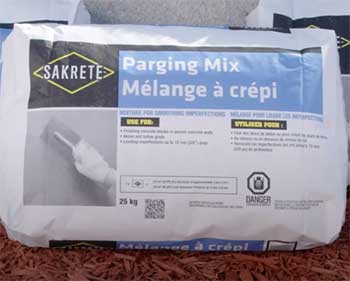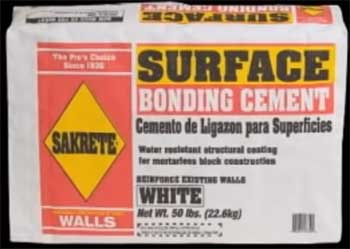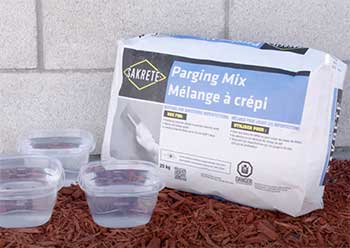Building or refurbishing structures constructed of blocks or bricks calls for an understanding of the many materials used in masonry.
Amongst them, surface bonding cement vs. parging is a topic of discussion. One product is fine as a bonding agent while the other significantly improves the appearance of a structure.
Using an incorrect mixture might require a do-over of the entire construction process – an expensive affair. To avoid a mishap like that, here’s what you must know about surface bonding cement and parging.
Quick Comparison Between Surface Bonding Cement and Parging
Check out the table below to take a quick glance at the differences between surface bonding cement and parging.
| Specification | Surface bonding cement | Parging |
| Composition | Portland Cement, modifiers, construction-quality fibers, and finely milled aggregates | Portland Cement and sand |
| Purpose | Base coating on masonry and concrete walls | Improve the appearance of a structure or save it |
| Function | Structural coat, additional layer of insulation for structures, retains walls | Enhance the cement or block structure’s appearance, water-proof the structure, seal cracks |
| Application | Three kinds of application based on the surface to be covered | A standard masonry trowel is used to apply thin layers |
| Benefits | Eliminates mortar joints, increases tensile strength, increases fire rating of the walls. | Easy-to-use and economical |
In-Depth Differences Between Parging and Surface Bonding Cement
Now that we know the basic differences, we can now explore the differences between the two in more detail.
- Composition

Surface bonding cement is a waterproof, high-density coating made from Portland Cement, modifiers, construction-quality fibers, and finely milled aggregates.
These materials are milled and mixed with other materials (like iron ore) before being heated to around 2,700 F.
Many times, bonding cement is simply called Portland cement. The story behind this goes all the way back to the 1800s.
An English mason named Joseph Aspdin of Leeds compared its hue to the stones from Portland’s quarries, an island off the coast of England.
Parging is a blend of Portland cement and sand, sometimes referred to as sand mix. The mix turns to a sticky solution when water is added. The consistency of the product has to be sticky, so it turns to a solid over a vertical structure and stays put.
You should be careful when adding water to parging as the mixture is quite delicate. A mixture too wet might crack whereas a mixture too dry would not attach to the wall.
- Purpose
Surface bonding cement is used as a base coating on masonry and concrete walls. Thanks to the fiber reinforcement in the mixture, concrete masonry units can be dry stacked. You don’t need mortar joints this way.
This material can also be used to give a decorative finish to existing block, poured, stone, brick, or terracotta walls.
The waterproofing qualities and high impact resistance of surface bonding cement make it perfect for surface crack-resistant finishes, as well as a base coat for exterior insulation systems and sturdy insulation boards.
Surface bonding cement increases the strength, water resistance, and durability of walls. It is perfect for adding to the beauty of walls, structures, and chimneys.
Moreover, bonding cement is extremely effective at fixing walls of older structures that have loosened or cracked over time.
Parging can be used to improve the appearance of a structure or even save it. This material is good over existing and new walls alike, and a great choice for both commercial and residential applications.
However, unlike surface bonding cement, parging cement isn’t a necessity when building structures.
Consider parging a helpful option. For instance, poured concrete walls and concrete blocks generally feature a rough texture that can be fixed by parging.
Parging can be used on foundations, columns, vertical surfaces, or any surface constructed of brick, stone, or concrete.
- Function

Parging cement has two main functions. Firstly, it can enhance the cement or block structure’s appearance.
This material is mainly added to a structure’s column or foundation to give it a decorated look.
Secondly, its application can also help to fail mortars remain strong.
There are many ways in which you can cover concrete, block, or stone walls, including parging and surface bonding cement.
A layer of surface bonding cement is one of the easiest ways to create a concrete, smooth finish over a cinder block wall.
Surface bonding cement provides an additional layer of insulation for structures while locking the moisture out. The result is a level surface that can be left like that or painted for a customized appearance.
As bonding cement contains acrylic and fiberglass, it’s easier to apply it vertically.
Furthermore, bonding cement is used as a structural coat for different dry-stacked constructions, on non-load bearing and load-bearing walls, on retaining walls, and on basement and foundation walls.
- Application
As the components used to make parging mixes are somewhat heavy, installers must remain cautious when applying them. Professionals only use thin layers of this material.
A standard masonry trowel is used to apply the mixture in super thin coats.
To start, the walls must be wet – this helps the mix stick to the masonry. Based on the wanted finish, the walls can be very smooth or heavily textured.
The installer must keep the trowel dripping wet when applying the parging if they want the walls to come out smooth. Most installers go in with a second layer of parging once the first coat has fully dried.
When it comes to surface bonding cement, there are three ways to apply it based on the surface: dry-stack block, rigid insulation board, and concrete and masonry. Here’s a summary of how bonding cement is applied for masonry and concrete.
Using a flat steel trowel, the installer will apply a thin coat of the surface bonding cement over the masonry and immediately double-back applying the material to the desired thickness. The minimum thickness for bonding cement is ⅛” while the maximum is ⅜”.
- Benefits

Parging is an easy-to-apply and economical solution to covering unappealing masonry.
It can effectively seal water damage and cracks, or even voids and holes. You can paint parged walls to complement the surroundings.
On the other hand, surface bonding cement eliminates mortar joints, increases the wall system’s fire rating, and increases flexural and tensile strength. Like parging, it seals and waterproofs.
And since it’s easy to do, it reduces labor costs and construction time.
Which One Is Suitable for You?
Between surface bonding cement and parging, it’s difficult to choose the standardized “better” solution. It entirely depends on your needs and what you want from the solution.
While parging is better to enhance the aesthetics of a structure, surface bonding cement makes it stronger.
While that does not mean parging does not contribute to the overall strength of a building, it surely isn’t a requirement when it comes to making structures.
Frequently Asked Questions (FAQs)
Surface bonding cement requires at least 24 hours to fully dry. After that, the area must be kept damp for at least 2 days.
In warmer climates, the material has to be slightly dampened to increase curing properties. In cold temperatures, cover and stop the material from hardening for a day.
While it’s not mandatory, replacing the 30% water requirement in parging with a light bonding solution increases the resilience of the mixture, making it less likely to slide off.
Parging is similar to stucco. It utilizes a masonry-based mortar instead of the conventional stucco mixture.
Acrylic stucco can be used as a viable alternative to parging on top of concrete foundation walls. That being said, acrylic stucco does not work on all kinds of concrete foundation walls. This sort of parging system could damage the final 3 layers of EIFS, or Exterior Insulation and Finish Systems.
On average, parging lasts between 30 to 50 years. Even after that, it generally requires repairs because of weathering.
Final Thoughts
Although bonding cement bears some resemblance to parging, the key difference lies in the use of special additives and glass fibers in cement.
Surface bonding cement includes fiberglass and an acrylic fortifier that add flexibility and strength to the application. Parging is great when you want to beautify the masonry of a structure.
We hope this article on Surface Bonding Cement vs. Purging helps you make the right choice based on your needs.

Free Materials! Broken Bags. Free in front of Home Depot. Sand mix first, then cover with countertop formula. Becomes SOLID almost instantly. Can hear the existing wall absorbing the moisture.
Informative and very helpful article. Thank you!